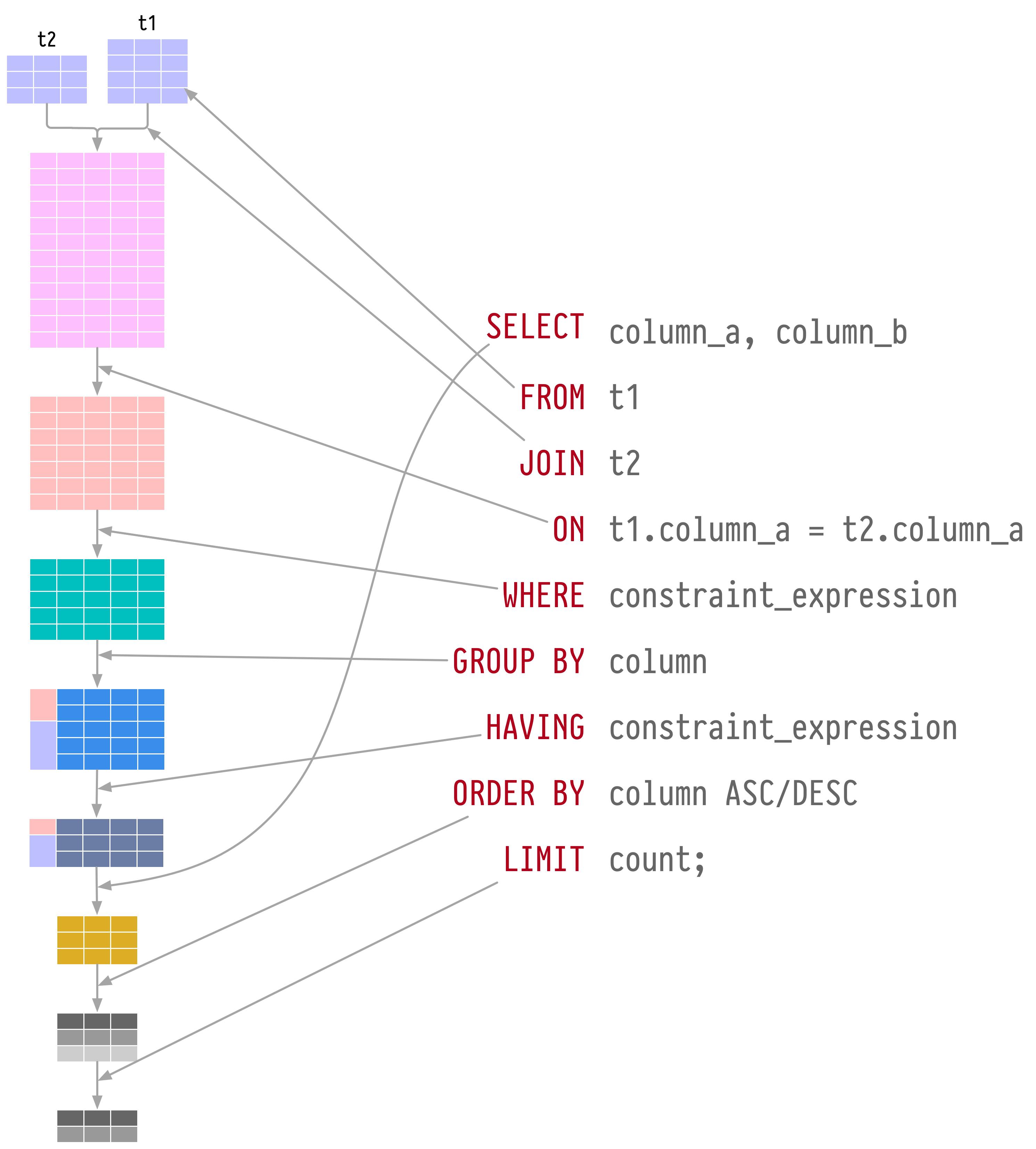Secret To Optimizing SQL Queries - Understand The SQL Execution Order ⚙️
Advance SQL Concepts
📍 Introduction
In this blog, we're going to deep dive into SQL query execution. We'll cover query processing, optimization techniques and best practices. Understanding the execution order of an SQL query is crucial for efficient and accurate database queries. It provides insights into query performance, aids troubleshooting, and enables code optimization for developers and administrators.
📍 Understanding SQL Execution Order
We write SQL query in a particular order but that's not how it is executed on the database. The SQL query execution order is the actual sequence in which the database engine processes the query components. By optimizing the execution order, the database engine can reduce disk I/O, utilize indexes efficiently, and minimize unnecessary operations. This optimization process improves query performance and response time.
Let's consider the following SQL query as an example:
SELECT customers.name, COUNT(order_id) as Total_orders,
SUM(order_amount) as total_spent
FROM customers
JOIN orders ON customers.id = orders.customer_id
WHERE order_date >= '2023-01-01'
GROUP BY customers.name
HAVING total_spent >= 1000
ORDER BY customers.name
OFFSET 100;
Step 1: FROM Clause:
The execution begins with the FROM clause, where the tables involved in the query are identified. In this example, the tables are customers and orders.
Step 2: JOIN Clause:
After identifying the tables, the database engine performs the necessary joins based on the join condition specified in the query. The join condition is customers.id = orders.customer_id, connecting the customers and orders tables. Using indexes on joint columns can significantly improve the performance of the joint operation.
Step 3: WHERE Clause:
Once the joins are complete, the database engine applies the filtering condition specified in the WHERE clause. In this example, the condition is order_date >= '2023-01-01', which selects orders made on or after January 1, 2023. Now, it's important to write a SARGABLE query to leverage indexes effectively, SARGABLE means Searched ARGUment ABLE and it refers to queries that can use indexes for faster execution.
We Deep-Dive into SARGABLE Queries later in the blog post.
Step 4: GROUP BY Clause:
Next, the database engine groups the rows based on the columns specified in the GROUP BY clause. In this example, the grouping is done based on customers.name, which groups the data by customer names.
Step 5: HAVING Clause:
After grouping the rows, the HAVING clause is applied to filter the groups based on a condition. In this example, the condition is total_spent >= 1000, which selects only groups with a total spent amount of 1000 or more.
Step 6: SELECT Clause:
Once the grouping and filtering are complete, the database engine selects the columns specified in the SELECT clause. In this example, it selects customers.name, COUNT(order_id) as Total_orders, and SUM(order_amount) as total_spent. Even though select comes first in a SQL query, it is pretty far down in the query processing order.
Step 7: ORDER BY Clause After selecting the columns, the ORDER BY clause is applied to sort the result set based on the specified column. In this example, the sorting is done in descending order based on customers.name.
Step 8: LIMIT Clause Finally, the LIMIT clause restricts the number of rows returned in the result set. In this example, it limits the result to a maximum of 100 rows.
📍 Visualizing a SQL Query Execution Order

📍Understanding SARGABLE Queries
SARGABLE (Search ARGument ABLE) queries in SQL refer to queries that can take advantage of indexes effectively to optimize search performance. The term "SARGABLE" indicates that the query is structured in a way that allows the database engine to perform efficient search operations using index-based retrieval.
Characteristics of SARGABLE Queries:
Index-friendly conditions: SARGABLE queries contain search conditions that can utilize indexes efficiently. These conditions typically involve comparisons using standard operators like "=", "<", ">", "<=", ">=", and "BETWEEN" on indexed columns.
Avoiding function usage on indexed columns: SARGABLE queries avoid applying functions or expressions directly on indexed columns in search conditions. Functions can prevent the use of indexes, leading to less efficient query execution. Instead, the indexed column itself should be used in the condition.
No implicit data type conversions: SARGABLE queries ensure that data types in search conditions match the data types of indexed columns. Implicit data type conversions can cause the database engine to bypass index usage and perform full table scans.
Conjunctions between indexable conditions: SARGABLE queries use logical conjunctions (AND) to combine multiple indexable conditions. This allows the database engine to leverage multiple indexes efficiently, narrowing down the result set based on the combined conditions.
Example:
A SARGABLE query on this table would be:
SELECT id, first_name, last_name
FROM users
WHERE created_date >= '2023-01-01' AND created_date < '2023-02-01';
In this example, the query is SARGABLE because it directly uses the indexed column created_date with a range condition. The search condition can take advantage of the index, allowing the database engine to efficiently retrieve the relevant rows based on the date range.
On the other hand, a non-SARGABLE query would be:
SELECT id, first_name, last_name
FROM users
WHERE MONTH(created_date) = 1;
In this non-SARGABLE query, the MONTH() function is applied to the created_date column. As a result, the database engine cannot use the index effectively, potentially leading to slower query performance.
📍Performance Tuning at Database Level
Improving performance in the SQL execution order involves optimizing the steps followed by the database engine to process and execute SQL queries. Here are some ways to enhance performance in the SQL execution order:
Use appropriate indexes: Analyze query patterns and identify columns frequently used in search, join, and filter operations. Create indexes on these columns to facilitate faster data retrieval and reduce the need for full table scans.
Optimize join operations: Ensure that join conditions are efficient and utilize appropriate indexes. Use INNER JOIN instead of OUTER JOIN when possible, as it typically results in better performance. Consider the order of joining multiple tables to minimize the intermediate result set size.
Limit result set size: Use the LIMIT clause to restrict the number of rows returned by a query. This can reduce the amount of data processed and improve query response time.
Avoid unnecessary sorting and grouping: Eliminate unnecessary sorting and grouping operations by only including them when required. This can be achieved by carefully analyzing the query and removing unnecessary ORDER BY and GROUP BY clauses.
Filter early with WHERE clause: Apply filtering conditions as early as possible in the query execution order using the WHERE clause. This reduces the number of rows processed in subsequent steps, improving performance.
Use appropriate data types: Choose the correct data types for columns to ensure efficient data storage and retrieval. Using appropriate data types can help reduce memory consumption and improve query execution speed.
Avoid unnecessary calculations and functions: Minimize the use of calculations and functions within the query, especially on indexed columns. These operations can hinder index usage and impact performance. Consider precomputing values or using derived columns when necessary.
Analyze and update statistics: Regularly analyze and update the statistics of tables and indexes. Accurate statistics enable the database engine to generate optimal execution plans based on up-to-date information about data distribution and cardinality.
Partitioning and parallelism: For large tables, consider partitioning the data to distribute the load across multiple storage units and enable parallel processing. Partitioning can significantly enhance performance for queries that access a subset of the data.
Query optimization tools: Utilize database-specific query optimization tools or hints to guide the database engine in generating efficient execution plans. These tools can provide insights, recommendations, and statistics to improve performance.
By implementing these strategies, you can enhance the SQL execution order and optimize query performance in your database environment. Remember that performance optimization should be based on thorough analysis, testing, and consideration of the specific characteristics of your data and workload.
📍Conclusion
Understanding the SQL execution order is vital for optimizing query performance and improving the overall efficiency of your database operations. By grasping the sequence in which the database engine processes SQL queries, you can strategically optimize different steps and leverage indexing, join operations, filtering, and other techniques to enhance performance. Additionally, incorporating SARGABLE queries, which are index-friendly and avoid unnecessary function usage, can further improve query execution speed. By following best practices, such as using appropriate data types, limiting result sets, and leveraging query optimization tools, you can achieve significant performance gains in your SQL execution order. Continuously evaluating and refining your queries based on performance metrics and database-specific characteristics will lead to efficient and high-performing database systems.
